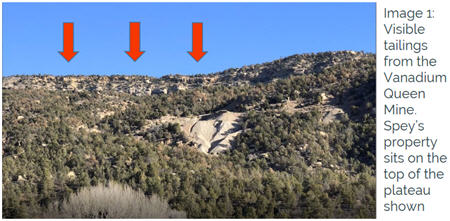
Vanadium is now a metals market squarely on the radar of all mining investors. It’s a critical input in the Power Revolution now taking place across the globe. Part of that Revolution is power generation. Investors are already familiar with the electric vehicle/lithium-ion battery equation and, more generally, the renewable power sources that are playing increasingly larger roles in power generation.
The other half of the Power Revolution centers on energy storage. To make this Power Revolution economically viable and logistically practical requires a vast commitment to increasing energy storage capacity. And the unique metallurgical properties of vanadium make it an ideal input in high-performance energy storage cells.
Vanadium pullback = buying opportunity
In recent months, the price of vanadium has retreated significantly from its US$34/lb peak in 2018 (currently at less than $15/lb). For mining investors looking to add exposure to this sector, the temporary softening of prices is good news: it allows investors to buy in at more favorable valuations. But it’s bad news for junior mining companies exploring for vanadium, right?
Direct that question to David Thornley-Hall, the President of
Spey Resources Corp. (
CSE: SPEY,
Forum) and investors may be surprised by the answer. More on this later. Who is Spey Resources?
This is a new, junior exploration micro-cap, via an initial public offering (IPO) in August 2018. In the current, depressed conditions across the mining industry, the Company sits with a compressed market cap of roughly $1 million. That equates to enormous leverage potential for mining investors – providing that there is an attractive asset on which to build.
(Geologist John Rud discusses Uravan Vanadium/Uranium Project)
In the case of Spey Resources, the Company’s flagship asset is its Uravan Vanadium-Uranium Property, situated in the state of Utah and located along the Uravan Mineral Belt – the historic epicenter of North American vanadium production. For investors doing their due diligence, there are additional noteworthy points here. It starts with Spey’s neighbour.
The Company’s largest and closest neighbour is
Energy Fuels Inc. (TSX: EFR, NASDAQ: UUUU). As already noted, valuations in the mining industry have been generally trending lower in recent years. The chart for EFR paints a much more positive picture.
 (click to enlarge)
(click to enlarge)
In a sea of declining mining market caps, Energy Fuels has been trending steadily higher. And even with the price of vanadium being cut in half, that company has continued to find strong support in the market.
For Energy Fuels, what has in part been driving its own valuation is its Utah-based La Sal vanadium-uranium mining complex and its fully permitted and operational White Mesa Mill. The White Mesa Mill is the
only conventional uranium/vanadium processing facility in the U.S.
It’s a great asset for Energy Fuels and it is currently producing high-purity vanadium at White Mesa, from the vanadium-rich mine tailings previously produced at La Sal. This Mill currently has excess capacity and
Energy Fuels has previously indicated that it is receptive to 3rd party toll-milling at White Mesa.
For Spey Resources and its investors, this all has great relevance. Being adjacent to the Energy Fuels property, the Uravan Property shares similar geology. Vanadium mineralization here is hosted in soft rock: sandstone-based channels that permeate the hard-rock geology.

Historically, previous mining took place on this Property from four mines, the Vanadium Queen, Firefly, Blue Cap and Gray Daun Mines. This was small-scale mining. When management was shopping for a prospective vanadium asset, they specifically avoided acquiring a land package with any history of large-scale commercial vanadium/uranium mining.
Marshall Farris, the Founder and CEO of Spey Resources elaborated on this strategy.
“At this stage in the Company’s development we felt it prudent to avoid any potential liability issues that could conceivably come from reclamation requirements associated with the former operating mine sites. Our technical team is confident that the sand channels hosting vanadium uranium mineralization at our Uravan project continue onto our property from the areas of the historic mining sites. A such we feel that the consistency of the geology in the region provides Spey with plenty of opportunity to define a vanadium resource while avoiding the old workings.”
In the tough conditions that currently exist for junior mining companies, it’s especially important for the management teams of these companies to be fully cognizant of any potential claims against shareholder capital. It’s also important for these companies to be able to stretch their dollars as far as possible – with respect to both operations and acquisitions.
President David Thornley-Hall explained why Spey Resources has not been concerned by the recent pullback in the price of vanadium.
“On one hand in this business you have to take what the market gives you. Elevated spot prices for metals can bring a positive environment for financing. But at the same time with peak pricing for a mineral commodity there can be tremendous competition for attractive project acquisitions that can drive those prices to unreasonable levels. With a certain amount of balance, a company can raise required exploration financing while being able to evaluate and acquire projects at reasonable terms. Sometimes this is a matter of timing and strategy.”
Maiden drilling planned for 2019
While Spey Resources sees current vanadium pricing as a sweet spot for its own operations, mining investors may equally see present parameters as representing an ideal entry window for taking a position here. The Company has already laid out its three-stage exploration plan including geological mapping, a radon survey followed by drilling to advance the Uravan Property and build value for shareholders.

While the geography of the Uravan Property is easily accessible, with its elevation level the snowcap will soon recede enough for on-site preliminary work to commence. Combining the data from the radon survey and geological mapping will allow the determination of initial drill targets, for drilling later this year.
One of the advantages of exploring for vanadium proximate to the La Sal complex is the generally high-grade vanadium mineralization. As an example,
historical data from the former (nearby) Firefly Mine indicates that the ore that was mined averaged grades of 2.04% V2O5 and 0.35% U3O8. The La Sal Mine now owned by Energy Fuels produced over 8.4 million pounds of vanadium between 2006 – 2012, along with 1.6 million pounds of uranium.
 (click to enlarge)
(click to enlarge)
With a mere $1 million market cap and drilling anticipated later this year, for some investors that alone is a strong enough value proposition to generate interest. However, given the nearby mill and mining-friendly jurisdiction, success in drilling would also open up the potential to commence small-scale commercial vanadium mining at Uravan – sooner rather than later.
Bootstrapping opportunity?
“Bootstrapping” is a mining term (and strategy) that isn’t nearly as common as it once was. But prior to the explosive commodities boom from 2005 – 2008 (when raising mining capital was much easier), smaller junior mining companies frequently adopted a bootstrapping strategy for advancing mining operations in a very economical manner that minimizes shareholder dilution.
In more specific terms, with a bootstrapping strategy a junior mining company seeks to build production incrementally, with minimal injections of capital. Developing a near-term revenue stream through early production can reduce future capital needs for exploration, even as small-scale mining operations yield additional mining data. Growth with minimum dilution.
The sandstone (soft rock) channels of vanadium-uranium mineralization at Uravan imply the potential for low-cost extraction. Excess mill capacity at White Mesa provides potential (cost-effective) processing without any capital investment in milling facilities.
With capital-raising more difficult today and market caps depressed, some management teams are reviving this thinking. Spey Resources represents a rare vanadium play that is positioned to build shareholder value in this cost-effective manner.
Current conditions in mining today are a challenge for the management teams running these companies, especially earlier-stage junior exploration companies. The flip-side to this is that when one of these companies (with their compressed market caps) makes a significant metals discovery or can otherwise advance operations, the potential payoff for investors is enormous. A recent
Stockhouse article showed how recent discovery successes in mining have translated into “ten-bagger” opportunities for investors.
As a new company, Spey Resources has a very tight share count: roughly 13.4 million issued and outstanding. With the pullback in vanadium prices providing an attractive entry opportunity for investors and Spey Resources looking ahead to maiden drilling at Uravan later this year, this is a leverage/revaluation opportunity in the vanadium market that may be too attractive for investors to resist.
www.speyresources.ca
FULL DISCLOSURE: This is a paid article of Stockhouse Publishing.